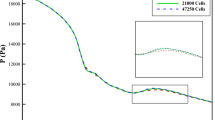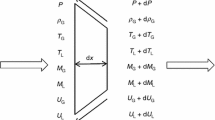Abstract
In supersonic adiabatic two-phase flows of steam, under the influence of supersonic acceleration, the fluid loses its equilibrium conditions and becomes supersaturated. Following this condition and to restore the fluid to equilibrium, micro droplets of water form in the absence of any surface or foreign particles. This phenomenon is called homogeneous nucleation and the formed minute small droplets grow along the fluid flow path. The formation of these droplets and their growth causes the release of the latent heat of evaporation to the gas phase particularly in the nucleation region, and results in an increase in the flow pressure which is called the condensation shock. In this paper, and in continuation of the series of papers by the authors, in addition to analytically solving the adiabatic gas-liquid supersonic flow of steam in a convergent-divergent channel, a novel solution to controlling the undesired effects of this pressure rise (condensation shock) is presented. In the proposed method, with the help of cooling the divergent section of the nozzle, the analytical model for the 1D non-adiabatic two-phase steam flows is further developed which shows considerable decrease in the intensity of the formed condensation shock. Also the growth rate of the formed droplets due to the cooling of the steam flow has higher importance than the nucleation itself.















Similar content being viewed by others
Abbreviations
- A :
-
Area
- C P :
-
Specific heat at constant pressure
- D e :
-
Equivalent diameter
- f :
-
Friction factor
- ΔG :
-
Change in Gibbs free energy
- J :
-
Rate of formation of Critical droplets per unit volume and time
- Kn :
-
Knudsen number (mean free path/droplet diameter)
- L :
-
Latent heat
- Ma :
-
Mach number
- m r :
-
Mass of droplet
- P :
-
Vapour pressure
- P 0in :
-
Inlet Total Pressure
- P s (T G ):
-
Saturation pressure at T G
- q :
-
Condensation coefficient
- R :
-
Gas constant for water vapour
- r :
-
Radius of droplet
- T :
-
Temperature
- T s (P):
-
Saturation temperature at P
- ΔT :
-
Degree of supercooling [T s (P)−T G ]
- t :
-
Time
- U :
-
Velocity
- v :
-
Specific volume
- \(\dot{q}\) :
-
Volumetric heat transfer rate
- \(\dot{Q}\) :
-
Total heat transfer rate
- Qc1 & Qc2 :
-
Volumetric Cooling (Heat rejection)
- M :
-
Total mass flow rate
- x :
-
Distance along Nozzle axis
- Xt :
-
Nozzle throat length
- X,Y :
-
Functions of temperature and density in equation of state
- α r :
-
Coefficient of heat transfer
- γ :
-
Isentropic component
- μ G :
-
Kinematic viscosity of vapour
- ζ :
-
Dryness fraction
- ρ :
-
Density of mixture
- λ :
-
Coefficient of thermal conductivity
- σ :
-
Surface tension
- ρ s (T L ,r):
-
Density corresponding to saturation pressure at temperature T L over a surface of curvature r
- Sc :
-
Schmidt number
- G :
-
Vapour phase
- L :
-
Liquid phase
- 0:
-
Stagnation condition
- S :
-
Saturation
- ∗:
-
Critical droplet
References
Mahpeykar MR, Teymourtash AR, Amiri Rad E (2011) Reducing entropy generation by volumetric heat transfer in a supersonic two-phase steam flow in a Laval nozzle. Int J Exergy 9(1):21–39
Mahpeykar MR, Amiri Rad E (2010) The suppression of condensation shock in wet steam flow by injecting water droplets in different regions of a Laval nozzle. Sci Iran, Trans B 17(5):337–347
Mahpeykar MR, Lakzian E, Amiri Rad E (2009) Reduction of thermodynamic losses in a supersonic nucleating steam nozzle by spraying water droplets. Sci Iran 16(3):253–262
Wroblewsia W, Dykas S, Gepert A (2009) Steam condensing flow modeling in turbine channels. Int J Multiph Flow 35:498–506
Bakhtar F, Zamri MY, Rodriguez-Lelis JM (2007) A comparative study of treatment of two-dimensional two-phase flows of steam by a Runge–Kutta and by Denton’s methods. Proc Inst Mech Eng, C J Mech Eng Sci 221(C6):689–706
Mashmoushy F, Mahpeykar MR, Bakhtar F (2004) Studies of nucleating and wet steam flows in two-dimensional cascades. Proc Inst Mech Eng, C J Mech Eng Sci 218(8):843–858
Senoo S, White AJ (2006) Numerical simulation of unsteady wet steam flows with non-equilibrium condensation in the nozzle and the steam turbine. In: ASME joint US-European fluid engineering summer meeting, Miami, Florida, USA, pp 757–767, 17–20
Gerber AG, Kermani MJ (2004) A pressure based Eulerian–Lagrangian multi-phase model for non-equilibrium condensation in transonic steam flow. Int J Heat Mass Transf 47(10–11):2217–2231
Bakhtar F, Young JB (1978) A study of choking conditions in the flow of wet steam. Proc Inst Mech Eng, C J Mech Eng Sci 192(21):237–242
Miller RC, Anderson RJ, Kassner JL, Hagen DE (1983) Homogeneous nucleation rate measurements for water over a wide range of temperature and nucleation rate. J Chem Phys 78(6):3204–3211
Wolk J, Stery R (2001) Homogeneous nucleation of H2O and D2O in comparison: the isotope effect. J Phys Chem 105:11683–11701
Wolk J, Stery R (2002) Empirical function for homogeneous water nucleation rates. J Chem Phys 117(10):4365–4377
Anisimov MP (2003) Nucleation: theory and experiment. Russ Chem Rev 72(7):591–600
Hale BN (2005) Temperature dependence of homogeneous nucleation rates for water: near equivalence of the empirical fit of Wolk and Stery and the scaled nucleation method. J Chem Phys 122(20):204509–204512
Bakhtar F, Young JB, White AJ, Simpson DA (2005) classical nucleation theory and its application to condensing steam flow calculations. Proc Inst Mech Eng, C J Mech Eng Sci 219(C12):1315–1333
Brus D, Zdímal V, Smolík J (2008) Homogeneous nucleation rate measurements in supersaturated water vapour. J Chem Phys 129(17):1–8
Cinar G, Yilbas BS, Sunar M (1997) Study into nucleation of steam during expansion through a nozzle. Int J Multiph Flow 23(6):1171–1188
Winkler G, Schnerr GH (2001) Nucleating unsteady flows in Low-Pressure steam turbine stages. J Power Energy 215(6):773–781
Moore MJ, Walters PT, Crane RI, Davids BJ (1973) Predicting the fog-drop size in wet-steam turbines. In: Proc. instn. mech. engrs., conf. publication, vol 3. pp 101–109
Mahpeykar MR, Taymourtash AR (2004) The effects of friction factor and inlet stagnation conditions on the self condensation of steam in a supersonic nozzle. Sci Iran 11(4):269–284
Vukalowitch MP (1958) Thermodynamic properties of steam, 6th edn. Mashigs, Moscow
Author information
Authors and Affiliations
Corresponding author
Appendix
Appendix
(I) Gas phase state equation Different methods have been proposed for the state equation of the two-phase flow. In this research considering the differential model of the flow, the virial state equation [21] is used:

where the B 1,B 2 and B 3 factors are known as the virial density factors which are functions of the gas phase temperature [9].
The differential state equation for a real gas is as follows:

where X and Y are defined as:


The Virial coefficients of Vukalovich’s state equation and the thermodynamic properties are as follows:

(II) The equation of specific heat at constant pressure:

(III) The equation of specific heat at constant volume:

(IV) The equation of isentropic index

(V) Vapour phase Mach number
The Mach number used in the governing equations of steam flow can be expressed as:

where C is the frozen speed of sound, i.e., in dry real steam.
Neglecting isentropic index variations, taking the logarithm and differentiating of the above equation gives:

Rights and permissions
About this article
Cite this article
Mahpeykar, M.R., Teymourtash, A.R. & Amiri Rad, E. Theoretical investigation of effects of local cooling of a nozzle divergent section for controlling condensation shock in a supersonic two-phase flow of steam. Meccanica 48, 815–827 (2013). https://doi.org/10.1007/s11012-012-9634-2
Received:
Accepted:
Published:
Issue Date:
DOI: https://doi.org/10.1007/s11012-012-9634-2




